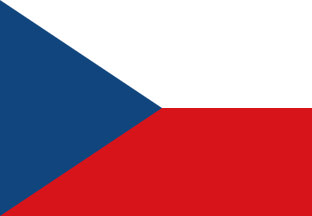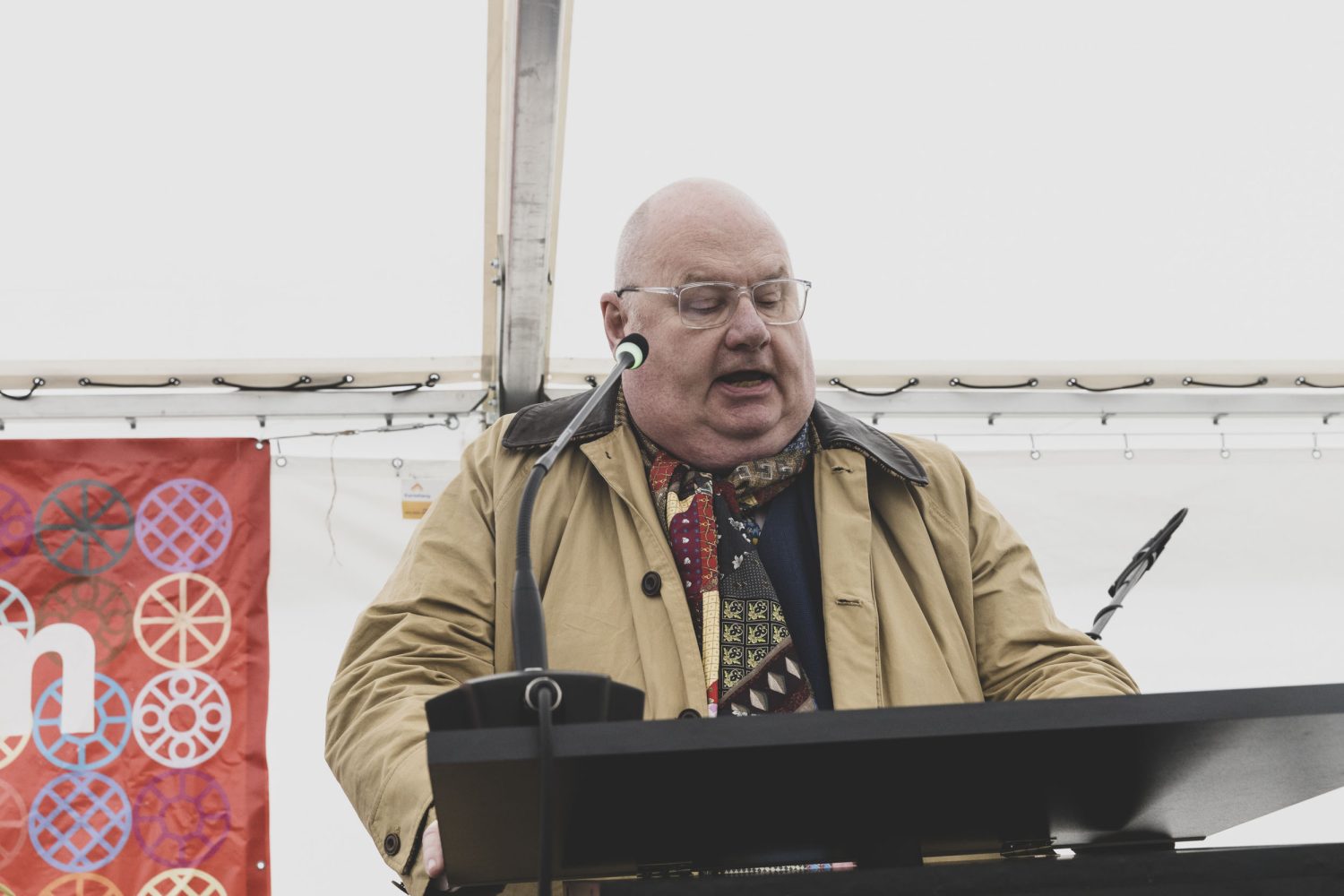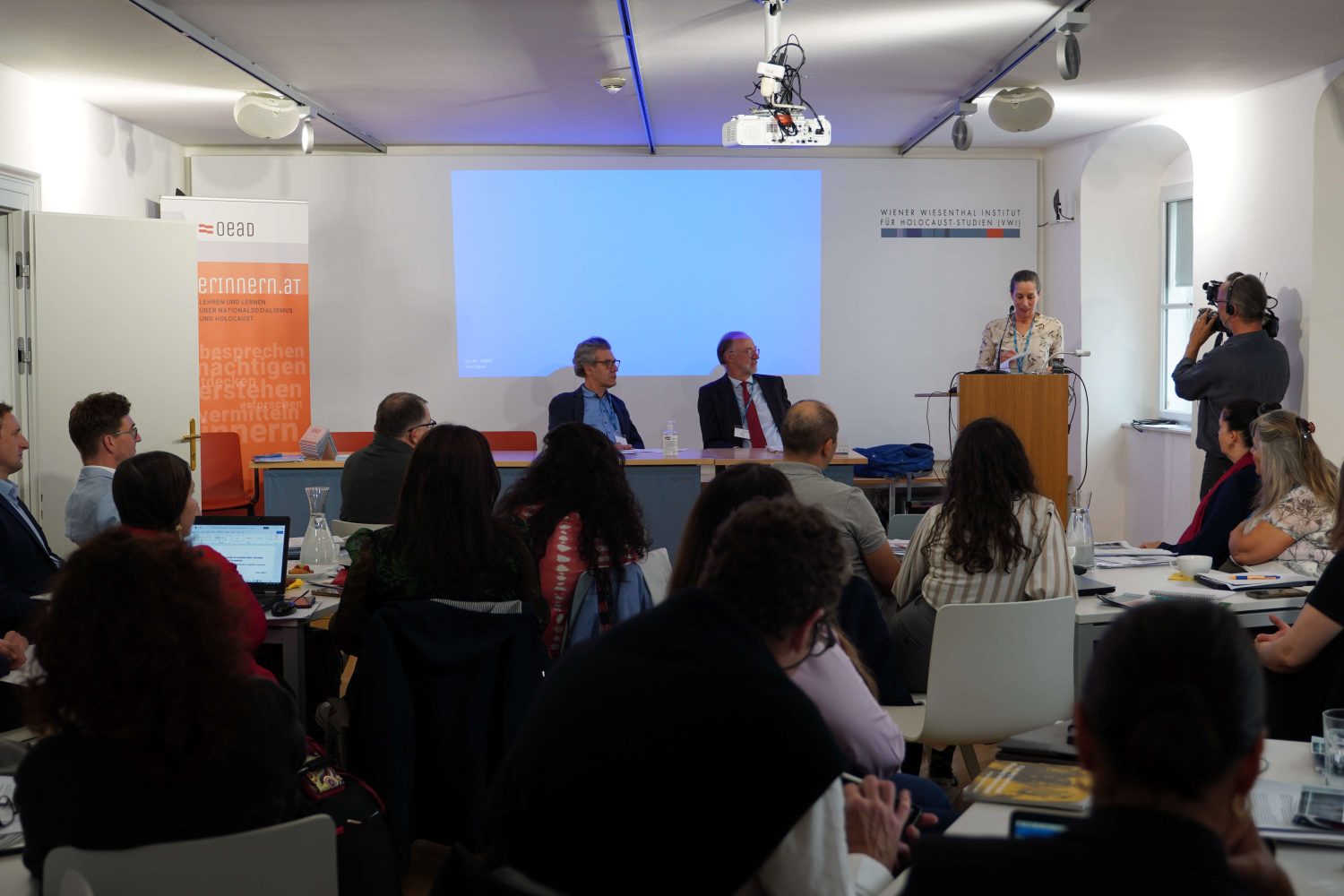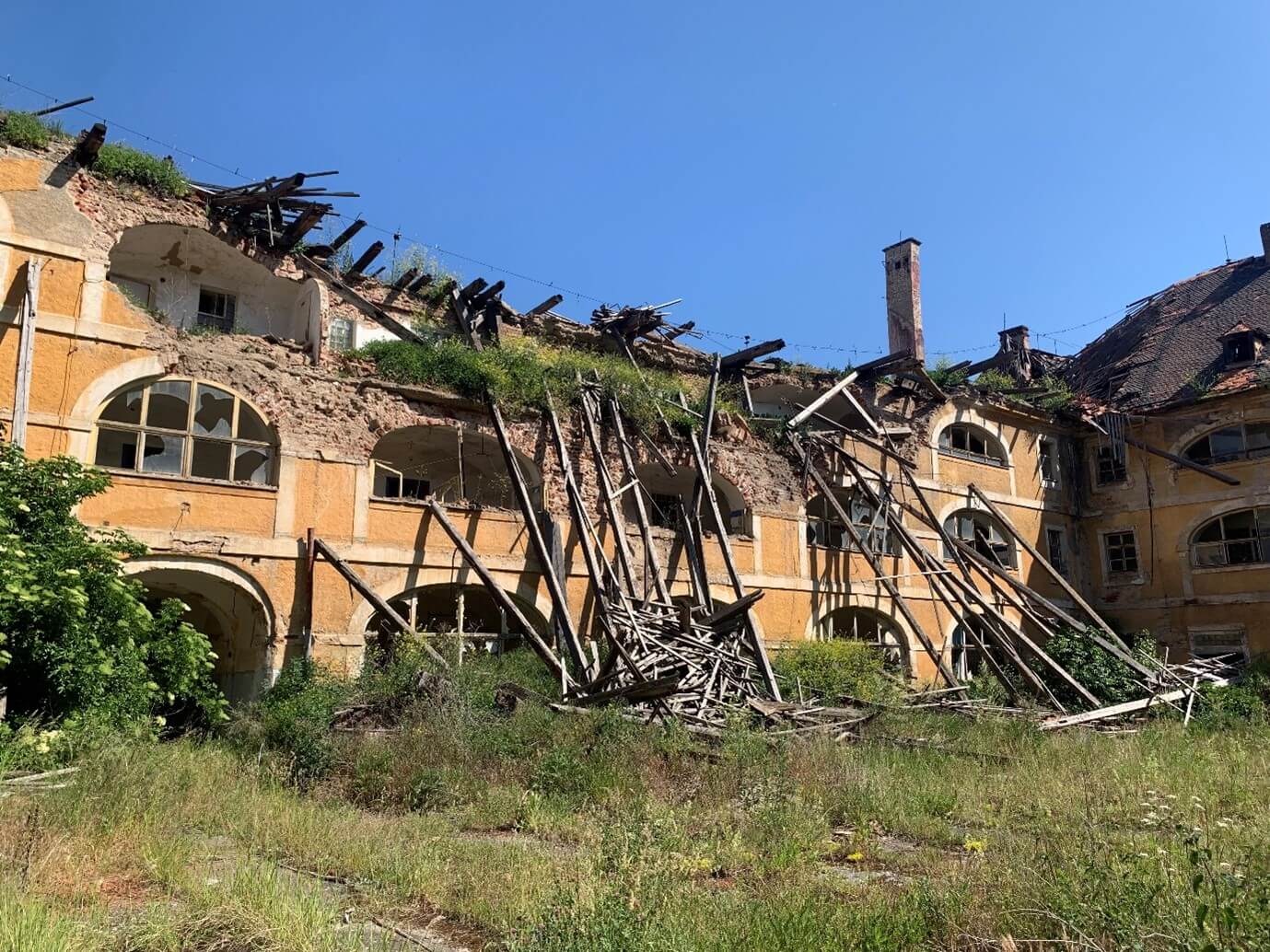
See all countries
- Argentina
- Australia
- Austria
- Belgium
- Bulgaria
- Canada
- Croatia
- Czech Republic
- Denmark
- Estonia
- Finland
- France
- Germany
- Greece
- Hungary
- Ireland
- Israel
- Italy
- Latvia
- Lithuania
- Luxembourg
- Netherlands
- North Macedonia
- Norway
- Poland
- Portugal
- Romania
- Serbia
- Slovakia
- Slovenia
- Spain
- Sweden
- Switzerland
- United Kingdom
- United States of America
Joined the IHRA
2002
International Holocaust Remembrance Day
27 January
Robert Řehák (Ministry of Foreign Affairs) – Head of Delegation
Jiří Kalašnikov (Ministry of Foreign Affairs) – Deputy Head of Delegation
Zuzana Pavlovská (Jewish Museum in Prague) – Education Working Group
Jan Roubínek (Terezin Memorial) – Museums and Memorials Working Group
Vojtěch Blodig (Terezin Memorial) – Academic Working Group
Marta Malá (Federation of Jewish Communities, Foundation for Holocaust Victims) – Education Working Group
Anna Míšková (Museum of Romani Culture) – Museums and Memorials Working Group
Hana Cetlová (Ministry of Education, Youth and Sports) – Education Working Group
Vojtěch Ripka (Anglo-American University) – Education Working Group
In the Czech Republic, the greater involvement in projects and discussions within the IHRA has led to a more open dialogue and increased cooperation among Czech NGOs and government authorities. The establishment of an efficient system of lifelong learning about the Holocaust for primary and secondary school teachers is another key achievement of Czech’s membership in the IHRA. Finally, continuous interest and encouragement from the IHRA leadership has helped the Czech government to resolve a longstanding issue and ensure that the sites of suffering from the time of the Nazi genocide of the Roma are protected and properly remembered.
Holocaust education, remembrance, and research in Czech Republic
All IHRA Member Countries are asked to complete a basic questionnaire with key facts about the state of Holocaust education, remembrance, and research in their country. The answers to the questionnaire, and to the Country Report, if available, are provided by the national delegations, who are also responsible for keeping the information up to date.
The most important political decision over the last seven years has been the adoption of the Definition of Antisemitism formulated by the IHRA. It was adopted by the Chamber of Deputies of the Parliament of the Czech Republic on January 25, 2019 on the occasion of the International Holocaust Remembrance Day (January 27).
Link: https://www.psp.cz/sqw/cms.sqw?z=12305
Regarding the Roma issue, the most important policy statement was the resolution of the Government of the Czech Republic in 2017 (Gov. Res. No. 609) on the purchase of a pig farm at Lety (Písek district) which was located on the site of a former gypsy disciplinary and labor camp and the construction of a dignified memorial. The purchase price was CZK 450 million (EUR 18 million), demolition, archaeological research and landscaping, including the construction of a monument CZK 123 million (EUR 4.9 million). At a later
stage, Norwegian Funds and IHRA contributed to the development of the site.
The Ministry of Foreign Affairs of the Czech Republic is preparing a follow-up International Conference to the Terezín Declaration in November 2022, as part of the Czech Presidency of the Council of the EU. The aim of the conference is to take another significant step in future Holocaust remembrance, education
of the young generation, rectifying property injustices from the time of the Holocaust and combating antisemitism (especially online). The event will be organized by the Office of the Special Envoy for Holocaust Issues. The aim of this conference is to achieve progress in rectifying property injustices from the time of the Holocaust, support for educational programs for young people and to create funds for combating antisemitism, xenophobia and hate, especially online.
Link: www.mzv.cz/terezindeclaration
Parallel with the preparations for the above-mentioned event, an inter-ministerial team of experts was set up to prepare the Czech National Strategy for Combating Antisemitism. The intention is to create a working platform for long-term efficient cooperation on combating antisemitism between the Ministry of Foreign Affairs, the Ministry of the Interior, the Ministry of Justice, the Ministry of Education, the Ministry of Culture and the Federation of Jewish Communities, with the coordination of the Special Envoy for Holocaust
Issues and an expert on terrorism, radicalization and antisemitism from the Ministry of the Interior.
The Federation of Jewish Communities runs a project with the aim to create an effective system of data collection and a gradual reduction in the number of unreported manifestations of antisemitism and to issue the Annual Report on Antisemitic Incidents in the Czech Republic.
Link: https://www.fzo.cz/en/projects/forum-for-combating-antisemitism,
https://www.fzo.cz/en/projects/forum-for-combating-antisemitism/annual-
reports-on-manifestations-of-antisemitism-in-the-czech-republic
In January 2022, the Federation of Jewish Communities in the Czech Republic in cooperation with the Jewish Museum in Prague and the Jewish Community in Prague launched the MANTIC Project – Manifestations of antisemitism in the Czech Republic – Monitoring, Analyses, Reporting and Application in Education. The main goal of MANTIC project is to fight antisemitism. It focuses primarily on improvement of monitoring antisemitic incidents, support of reporting antisemitic incidents by Jewish entities and public. The MANTIC Project releases the above-mentioned Annual Report on Antisemitic Incidents in the Czech Republic and presents the conclusions of the annual report to the general public and governmental authorities. The goal is to increase the awareness among pupils and students about current antisemitic incidents as well as to support teachers and educators. The project is co-financed by the European Union through the CERV program.
Link: https://www.fzo.cz/en/projects/forum-for-combating-
antisemitism/project-mantic/
Official remembrance/memorial events related to the Holocaust and other Nazi crimes have a long tradition in the Czech Republic. National holidays and remembrance/memorial days are approved by Act No. 245/2000. Based on a decision of the Czech parliament, the following days related to the Nazi occupation and Nazi crimes committed in Czech Republic are included among remembrance days in the Czech Republic: January 27 – Memorial Day for the Victims of the Holocaust and Prevention of Crimes against Humanity; March 9 – Memorial Day for the Victims of Annihilation of the Theresienstadt Family Camp in Auschwitz-Birkenau; June 10 – Memorial Day for the Victims of the Annihilated Village of Lidice.
The main events on Memorial Day for the Victims of the Holocaust and Prevention of Crimes against Humanity in Prague are organized by the Federation of Jewish Communities in the Czech Republic and the Foundation for Holocaust Victims in cooperation with the Senate of the Parliament of the Czech Republic. A further ten Jewish communities in the Czech Republic, organize similar memorial events on this day, usually in cooperation with the local authorities. In recent years, the Holocaust is also commemorated at the Ministry of Foreign Affairs in cooperation with the State of Israel, the United States, Germany and other countries.
Every year a memorial service is held at the Pinkas Synagogue (Memorial to the Shoah Victims) in memory of the murder of 3792 prisoners of the so-called Theresienstadt Family Camp in Auschwitz-Birkenau on the night of March 8-9, 1944, which was the largest massacre of Czechoslovak citizens during WWII.
Yom HaShoah Day is commemorated in many cities in the Czech Republic by the public reading of the names of the victims of the Holocaust and the Romani genocide.
Link: http://www.terezinstudies.cz/sd/news/hlavni-stranka/220407_jom_ha_soa_2022.html
The Terezín Commemoration Ceremony (Terezínská tryzna) is one of the main venerating events honoring the memory of Holocaust victims. It takes place on the third Sunday in May and is attended by survivors, government officials at the highest level and the representatives of various organizations. These events are attended by political and civil society representatives.
Each year, the Museum of Romani Culture commemorates the anniversary of the first deportation of Roma from the Protectorate to the Auschwitz-Birkenau concentration and extermination camp March 7, 1943.
The Museum also commemorates August 21st, which is the date of the biggest deportation of Romani prisoners from the Protectorate’s so-called “Gypsy” camp in Hodonín u Kunštátu to the Auschwitz-Birkenau extermination and concentration camp in 1943. The reverent gathering takes place at the Hodonín Memorial and Žalov Memorial each year in August on a Sunday nearest to the date of this largest deportation of Romani prisoners. The commemoration ceremony in Lety u Písku is traditionally held on May 13th inremembrance of the largest deportation of the prisoners from Lety to Auschwitz-Birkenau. It is organized by the Committee for the Redress of the Roma Holocaust, in cooperation with the Museum of Romani Culture. Roma Holocaust Memorial Day takes place the August 2nd. There are also several
memorial events that traditionally take place in various location in the Czech Republic. Numerous delegations are sent to the commemoration in Auschwitz-Birkenau.
There are several academic programs in the Czech Republic, especially at Charles University in Prague and Palacký University in Olomouc, which focus on the Holocaust as part of their undergraduate and graduate studies.
The Centre for the Study of the Holocaust and Jewish Literature
Link: https://holokaust.ff.cuni.cz/en
Prague Centre for Jewish Studies
Link: https://pcjs.ff.cuni.cz/en
The academic Holocaust research in the Czech Republic is conducted mainly by the Institute of Contemporary History and the Masaryk Institute and Archives of the CAS, v.v.i.
Link: https://www.usd.cas.cz/en/
Link: https://www.mua.cas.cz/en
The collected data are used in the study fields at the above-mentioned universities.
Various governmental and particularly non-governmental institutions have been researching the causes and consequences of the Holocaust for several years. Applied research is in the absolute majority of cases conducted by non-governmental organizations. Their work is supported by the government through subsidy schemes for non-governmental organizations.
One of the primary Holocaust research centers in the Czech Republic is the Terezín Memorial. It carries out this research in cooperation with other facilities, particularly the Jewish Museum in Prague and the Terezín Initiative Institute.
The Terezín Memorial also works with other scientific institutions (Centre for Economic Research and Graduate Education of Charles University, Institute for Democracy and Economic Analysis in Prague) in the framework of the Grant Agency of the Czech Republic on inter-disciplinary research on the Holocaust in the Czech lands generally and in the Terezín (Theresienstadt) ghetto specifically.
The Institute for the Study of Totalitarian Regimes (Ústav pro studium totalitních režimů) has, since its establishment in 2008, been working on commemorating Holocaust victims and other individuals persecuted in the Czech lands by the occupying Nazi regime. This institute has become an important center for researching the crimes of the two totalitarian regimes that have existed on the territory of today’s Czech Republic. It offers specific foci with its projects on persecution of Czechoslovaks, particularly with Jewish roots, in the labor camps of the USSR, or post-war antisemitism.
Link: https://www.ustrcr.cz/en/
Link: https://cechoslovacivgulagu.cz/en/index.html
Link: https://antisemitismus4589.dejepis21.cz/
Prague Forum for Romani Histories
In the Czech Republic, most of the research on Holocaust-related issues is conducted by non-profit organizations or museums. In recent years, their results have been published online, making them more accessible to the general public. The presentations also include proceedings, publications, and other materials in electronic form. Among the most important outputs of the last 7 years is the website www.holocaust.cz. The website includes the Victims Database, which contains information about more than 170 000 prisoners held in Terezín, Lety u Písku and other Nazi ghettos and concentration camps, supplemented by authentic portrait photographs and an archive of documents, especially of an official nature.
Link: https://www.holocaust.cz/en/main-2/
MemoGIS Prague – A new web application presents the persecution of Jews in Prague. The web application called MemoGIS Praha (Memo stands for memory, GIS – Geographical Information System) was created by the Masaryk Institute and the Archives of the CAS in cooperation with the Terezín Initiative Institute and the Multicultural Centre Prague. The project was supported by the Technology Agency of the Czech Republic and will be further developed within the Czech hub of the European Holocaust Research Infrastructure. The application loads data from the Victims Database into the current map of Prague. Along with the application, a didactic guidebook Faces, Places, Fates: using MemoGIS in teaching was also created.
Link: https://www.holocaust.cz/databaze-obeti
Link: https://ehri.cz/memogis/praha/?l=praha_statistika%2CIncidenty_v_prostoru_mesta_Prahy%5B20%5D%2CBody_zajmu%2CBydliste_Zidu_v_Praze_v_dobe_okupace%5B15%5D%2CObeti_holokaustu_z_Prahy%2CHistoricka_mapa_Prahy&bl=mapnik&t=memogis_prague_CZE_csv.qgz&c=1605459%2C6460757&s=80000
The Jewish Museum in Prague (JMP) coordinated the EHRI-2 (European Holocaust Research Infrastructure) project, the aim of which was to launch the online Terezín Research Guide, which provides access to archival documents stored in the archives of various countries. Since 2020, the JMP has also been working on the follow-up EHRI-3 project, through which it gives doctoral students and other researchers access to the collections stored at its Archive Department.
Link: https://www.ehri-project.eu/consortium
Recent anthologies include The Holocaust in the Bohemian Lands, published in 2021 and the anthology Transgenerational Trauma (Not Only)Transfer, edited by Marek Preiss and Daniela Vizinová. The Roma genocide is being addressed by: Jana Horváthová et al. – … these are difficult memories; Markus Pape – Solo by Jiří Letov; Jiří Smlsal – The Holocaust of the Czech and Moravian Roma; Pavel Baloun – “Gypsies, the scourge of the countryside!” The creation and application of anti-Gypsy measures in interwar Czechoslovakia, during the Second Republic and in the initial phase of the Protectorate of Bohemia and Moravia (1918-1941). The other study is called The Last Ghetto, An Everyday History of Theresienstadt.
Link: https://simon.vwi.ac.at/index.php/simon/issue/view/17
Link: https://global.oup.com/academic/product/the-last-ghetto-
9780190051778?cc=us&lang=en&
The gender aspect of the life of Czechoslovaks in concentration camps was surveyed by Pavla Plachá in her „Zpřetrhané životy“ [Ruptured lifes] in 2021.
The fates of Czechoslovak Jews that escaped to the USSR was described in „Jews in Gulag“ by Adam Hradilek and Jan Dvořák in 2017. The Czechoslovaks in Gulag includes a collection of documents and testimonies online.
Link: https://cechoslovacivgulagu.cz/en/o_projektu.html
Link: https://www.ustrcr.cz/publikace/jan-dvorak-adam-hradilek-zide-v-gulagu-sovetske-pracovni-a-zajatecke-tabory-za-druhe-svetove-valky-ve-vzpominkach-zidovskych-uprchliku-z-ceskoslovenska/
The post-war situation of Jews on the territory of the Czech Republic is mainly reflected in these publications, which are based on research carried out in academia, especially at the Charles University in Prague:
Hana Kubátová a Kateřina Králová – Returns: The Postwar Reconstruction of Jewish Communities in Central, Southeastern and Eastern Europe;
Alena Heitlingerová – In the Shadow of the Holocaust and Communism: Czech and Slovak Jews after 1945;
Jan Láníček – In the Shadow of the Shoah: The Czechoslovak Government in Exile and the Jews during and after World War II;
Martin Wein – History of the Jews in the Bohemian Lands;
Martin Šmok – The Labyrinth of Normalization.
Jaroslav Pinkas (ed.): Antisemitismus 1945 – 1989
Státní politika proti Židům v Československu (primarily an educational text
and a source book.
Among the latest textbooks and teaching materials on the Holocaust is the methodological material: Recommendations for Teaching and Learning about the Holocaust, published by the IHRA and translated by the Ministry of Education, Youth and Sport.
There is also a project “Ours or Strangers. Jews in the Czech 20th Century” which should simplify achieving expected results in school history related to the 20th century.
Link: http://www.nasinebocizi.cz/
Teaching materials on the history of Jews in the Czech lands in the 20th century for primary and secondary schools. The project will help teachers with the implementation of curriculum reform and aims to provide teachers with sufficient materials to teach the often neglected 20th century. The project is conceived as a means of prevention for manifestations of racism and xenophobia. The promotion of understanding between people of different religions, skin color and origin creates a tolerant civil society sensitive to
manifestations of injustice, racism and xenophobia.
Jews, History and Culture – The book is intended for schools, a type of textbook designed for teaching history, civics and literature, updated edition in 2021, Jewish Museum in Prague.
A serious, popular digital simulation game “Czechoslovakia 38-89: Assassination” has been accompanied by supplementary educational guides for teachers that address both the Holocaust and the genocide of Roma.
The game itself
Link: http://cs3889.cz/locale/en_US/article.do?articleId=1310
Educational supplement
Link: https://www.dejepis21.cz/ceskoslovensko-38-89
An educational multimedia set “Images of War” integrates the historical cultures of the Holocaust and genocide of Roma as one of its prime topics.
Link: https://obrazyvalky.dejepis21.cz/
HistoryLab, a complex online learning environment aimed at fostering historical thinking, includes a number of activities that uncover the history of Holocaust and genocide of Roma and the memory thereof. A sample activity in English:
Link: https://historylab.cz/cviceni/what-happened-at-croydon-airport?from=homepage
There has not been any survey specifically addressing the effectiveness of teaching and learning carried out in this regard. However, two reports present data that are relevant to the shape, size and context of teaching and learning of this topic.
Czech Schools Inspectorate: Thematic Report – Teaching of Contemporary History in Elementary and Secondary Schools.
The report from 2016 indicates a relatively high level of interested students in the Holocaust as an issue (p. 21), it also indicates a high usage of educational resources by the Terezín Memorial, the Institute for the Study of Totalitarian Regimes and the Jewish Museum. This shows relatively high attention paid to the respective issues, especially in upper secondary schools. A more complex survey of the teaching and learning of modern history is scheduled by the Czech school inspectorate for autumn 2022.
“Prejudices in Czech society and how to work effectively with them at school”
In collaboration with the Institute of Sociology of the Czech Academy of Sciences, a research project on antisemitic and anti-Roma prejudices and the manner they are being handled by educational initiatives, has been carried out with the support of EVZ foundation in 2017-2018. The final completed report in Czech, gives a summary of the available information about the educational organizations dealing with the Jews and Roma in the Czech Republic.
The Report outlines the institutional framework, in which tolerance education plays out in the Czech school system, offers the results of the qualitative research on the organizations and schools and the recommendations based on it, and concludes with studies about Czech societal attitudes towards Roma
and Jews.
Link: http://stereotypy.cz/
The main memorial site for Holocaust victims is the town of Terezín, specifically the Terezín Memorial. The Department of History of the Terezín Memorial has been digitalizing collections and creating specialized databases of individuals persecuted by the occupying Nazi regime during World War II. In 2020, these databases were merged into the “Database of Politically and Racially Persecuted Persons”. Its main section is a database of prisoners of the Terezín (Theresienstadt) ghetto and of individuals, who were deported from the Czech lands directly to the ghettos in Lodz, Minsk and Ujazdów. These include Jews from the Czech lands, who became victims of Nazi reprisals not only in the Protectorate of Bohemia and Moravia, but also in other territories controlled by Nazi Germany. In connection with the mentioned EHRI
digitalization project, the EHRI – CZ project is to be implemented in the coming years.
Link: https://www.pamatnik-terezin.cz/?lang=en
The Jewish Museum in Prague with the Holocaust Victims Memorial in the Pinkas Synagogue is a unique remembrance site. Established in the 1950s, at the time of one of the fiercest anti-Semitic campaigns launched by the Communist regime, the memorial consists of a list of 75 thousand Jewish victims inscribed on the walls of the synagogue. The Memorial is unique in terms of the time of its creation, location, artistic concept and simplicity (it is one of the first large name-based Holocaust memorials).
Link: https://www.jewishmuseum.cz/en/info/visit/
The Jewish Museum in Prague, working with Czech and foreign partners (Terezín Memorial, Yad VaShem, Bejt Terezin), coordinated the EHRI-2 (European Holocaust Research Infrastructure) project, the aim of which was to launch the online Terezín Research Guide, which provides access to archival documents stored in the archives of various countries.
There are two important organizations in the Czech Republic that bring together Holocaust survivors and their descendants and contribute to educational and memorial projects. The first is the Terezín Initiative, which, in cooperation with the Terezín Memorial, organizes Czech schools’ field trips to the Terezín Memorial. The second is the Czech Auschwitz Committee, which has created and operates its own travelling exhibition entitled “Places of Suffering, Death and Heroism – Prisoners from the Czech Lands in Nazi Concentration Camps”.
Other projects commemorating the victims of the Shoah include the international Stolpersteine project, which is widespread in the Czech Republic. The so-called Stones of the Disappeared are placed in the pavement in front of the houses from where the Jews were deported.
Link: https://stolpersteinecz.cz/
In 2012, the publicly beneficial organization Prague Shoah Memorial was established. It has drawn up a project for the reconstruction of the Bubny railway station in Prague 7, from which over 50 000 Jews were transported to concentration camps during World War II. In 2020, the Government of the Czech Republic approved the plan to establish the Memorial of Silence (Památník ticha) project. The plan is to build a memorial designed as a discussion center and educational space with a permanent exhibition, several
seasonal exhibitions and debate projects.
Link: https://www.pamatnikticha.cz/en/
A specialized department of the Museum of Romani Culture has been documenting and researching the genocide of the Roma, especially on the territory of the former Czechoslovakia. Since the very beginning, museum staff have also given special attention to chronicling the cultural values and events from the history of the Roma on audio and video. For example at present, hundreds of hours of recordings of personal stories and experiences in the 20th century, as well as crafts, artwork, literature, music, song, dance, traditional recipes, holiday and family celebrations, etc. are accessible at the Museum for researchers and for the public.
Link: https://www.rommuz.cz/en/
Two locations where the Roma suffered during World War II – Lety u Písku and Hodonín u Kunštátu – were placed under the Museum’s management with the main aim of building and opening memorials there. The Memorial to the Holocaust of the Roma and Sinti in Moravia was opened to the public in Hodonín u Kunštátu in 2020 and the Memorial’s main exhibition in July 2021. The Museum thus completed work that was begun on the memorial by the National Pedagogical Museum and Library of J.A. Comenius (NPM) in 2012. The museum also held an international architectural-landscape competition for the new memorial to be built at Lety u Písku, with the winning proposal being chosen in 2020 and work on demolishing the former pig farm and building of the memorial with a new exhibition is now under way. The Museum
has also received an IHRA Grant (2019–2021) to help their experts with creating the concept for the exhibition at the Lety Memorial. The Lety Memorial and newly built Centre for the Roma and Sinti in Prague (both funded by the Norway Grants) should be open to the public in 2023.
Post Bellum is another important non-governmental organization devoted to recording and providing access to memorials of eyewitnesses. This organization has been collecting eyewitness accounts of key events of the 20th century since 2001. “National Remembrance” has become its flagship project. Its aim is to collect the testimonies, photographs and documents of thousands of individuals, including many survivors of the Holocaust.
Link: https://www.postbellum.cz/english/
Living Memory (Živá paměť), a non-governmental organization that offers lectures on Roma Holocaust and discussions with Roma eyewitnesses for primary and secondary school pupils and university students.
The memorial museums in the Czech Republic respect in their activities the International Memorial Museum Charter, which was adopted in 2012 with an addendum adopted in 2016. They are also represented in the international organizational framework of the Committee of Memorial Museums (IC MEMO) which is integrated into the International Council of Museums (ICOM). Czech memorial museums present the historical events in a way that evokes empathy with the victims as human individuals and groups, which were targeted for persecution. The fact that they are located in historically authentic sites, where public crimes against humanity and minorities were committed enhances the impact of the educational work. Some educational programmers work in cooperation with two or more partners on a joint project. This is often the case in the preparation and realization of teacher-training seminars. As an example could be the mentioned teacher-training seminar “How to teach the Holocaust” which is realized every year in cooperation with the Jewish Museum in Prague, the Terezín Memorial and the Museum of Romany Culture in Brno. An important part of the cooperation of memorial museums’ work is the regular exchange of materials and information. That practice includes also cooperation with partners from abroad. Prior to the pandemic, joint seminars for teachers and museum workers were organized with partners in Poland, Germany and Israel. This practice should be renewed again soon.
The Terezín Memorial (Památník Terezín) is a state-funded organization of the Czech Ministry of Culture and is therefore being financed from the state budget. The key mission of the Terezín Memorial is to commemorate the victims of the Nazi political and racial persecution during the occupation of the Czech lands in WWII, to promote museum research and educational activities, and to care for the memorial sites commemorating the suffering and death of hundreds of thousands of violence victims. The annual contribution of the Ministry of Culture to the Terezín Memorial is CZK 100 million (EUR 4 million).
Link: https://www.pamatnik-terezin.cz/?lang=en
The Museum of Romani Culture (Muzeum romské kultury) was founded in 1991 as a non-profit organization at the initiative of Roma intellectuals. Since 2005, the Museum of Romani Culture has become a state contributory organization of the Ministry of Culture. It is a unique institution worldwide. Since the beginning, the Museum has primarily sought to establish collection funds (approx. 25K collection items) documenting the Romani culture and history. Today it administers the funds of traditional crafts and professions, types of dwellings, interior furnishings, clothing and jewelry, fine arts, written materials, posters and invitations, audio, photo and video documentation, library, echoes of the Romani culture in the culture of the major society and the auto-documentation fund of the Museum. The annual budget of the Museum of Romani Culture is CZK 35 million (EUR 1.4 million).
Link: https://www.rommuz.cz/en
The Memorial of Silence (Památník ticha) was established in 2021 as state subsidized organization of the Ministry of Culture. Its mission follows the public benefit corporation Memorial of the Shoah Prague, bears its project name, and continues its efforts to transform the railway station, marked by the deportation of nearly fifty thousand Prague Jews from the Protectorate of Bohemia and Moravia (see above for more information). The planned budget for 2021-2025 is for reconstruction CZK 190 million (EUR 7.6 million),
management CZK 91 million (EUR 3.6 million) and projects CZK 240 million (EUR 9.6 million).
Link: https://www.pamatnikticha.cz/en/
The Documentation Centre for Property Transfers of the Cultural Assets of WW II Victims (Centrum pro dokumentaci majetkových převodů kulturních statků obětí II. světové války) was founded and later transformed into a public beneficial organization (formerly the “Mixed Working Commission for mitigating property injustices inflicted on Holocaust victims”, which was active from 1998 to 2002). The budget for the years 2022-2028 is CZK 99 million (EUR 3.99 million).
Link: www.cdmp.cz
The Foundation for Holocaust Victims (Nadační fond obětem holocaustu) was established in 2000. The Chamber of Deputies of the Parliament of the Czech Republic allocated CZK 300 million (EUR 12 million) to the Foundation, with a third of these funds being used to indemnify those who, due to racial persecution, had their property confiscated during the occupation and had their property neither returned nor received compensation. The Foundation contributes to social, health and psychological care for Holocaust survivors,
to the restoration of Jewish monuments, to Judaism education, to the development of Jewish communities and to Holocaust-related educational and commemorative projects. The Government of the Czech Republic provides regular aid, and the Ministry of Culture of the Czech Republic signed a long-term funding agreement with the Foundation. In 2014, the Government of the Czech Republic provided CZK 100 million (EUR 4 million) for the period of 2015-2019, and in 2019 an additional CZK 100 million for the period of 2020-2024 (total amount EUR 20 million). The Foundation actively supports key education projects and dignified memorials to Jewish and Romani victims of Nazi persecution.
Link: https://fondholocaust.cz/en/homepage-cs-english/
The Institute for the Study of Totalitarian Regimes (Ústav pro studium totalitních režimů) is a governmental institution with a direct funding from the state budget. In 2021, its funding amounted to CZK 108 million (i.e., approx. EUR 22 million), while the yearly subsidies since its inception in 2008 have been roughly at the same level.
Link: https://www.ustrcr.cz/wp-content/uploads/2022/04/VZ_2021.pdf
The Jewish Museum in Prague (Židovské muzeum v Praze) is an independent institution without state support. However, the Museum receives state support for some of its many activities in education, Holocaust documentation and security. The projects are financially supported by the Ministry of Education, Youth and Sports, the Ministry of Culture and the Ministry of the Interior.
The most important decision was the adoption of the Definition of Antisemitism formulated by the IHRA (Resolution of the Chamber of Deputies No. 463 from January 25, 2019).
Link: https://www.psp.cz/sqw/text/text2.sqw?idd=154253
Link: https://www.psp.cz/sqw/cms.sqw?z=12305
